Chinese banks continue to dominate The Banker’s latest global ranking of Top 1000 banks, but they are showing signs of slowing down. Their profits fell 3.5% – the first drop since 2004 – and bad loans are on the rise, reflecting a weaker Chinese economy.
For the last few years China’s banks have dominated the ranking based on Tier 1 capital. This year Industrial and Commercial Bank of China (ICBC) remains number 1 and China Construction Bank number 2, with 4 out of the top 5 places held by Chinese banks.
“Major Chinese banks grew their capital faster than their assets last year suggesting that they are becoming cautious and there are also signs of rising bad loans,” said The Banker’s editor Brian Caplen. “All the same, Chinese banking profits are by far the world’s largest and far higher than those of US and European banks.”
US banks did well in the ranking with JP Morgan placing third, Bank of America 6th, Citigroup 7th and Wells Fargo 8th.
French banks remain competitive, with Credit Agricole staying in 11th place and BNP Paribas in 12th. French bank profits grew by 30% while both UK and German banks lost ground.
UK bank profits fell 22% and HSBC is now the only British bank in the global top 10, placing 9th. The outlook for UK banks is even more uncertain following the surprise UK vote to leave the European Union. Back in 2006, before the financial crisis, HSBC was the world’s second largest bank, and Royal Bank of Scotland the 7th largest. Losses at Royal Bank of Scotland and Standard Chartered, and profit falls at Barclays and Lloyds, helped pull down UK profits.
German bank profits fell 63%, reflecting an impact from the eurozone crisis, and are now behind those of Azerbaijan, Kazakhstan, India and Brazil. Germany’s leading bank Deutsche fell into a loss and an 18% decrease in capital – the largest among the top 25 banks – sent the bank tumbling from 16th to 21st in the global ranking.
Back in 2006 Europe’s banks contributed 42% of global banking profits. Now they only contribute 16%. By contrast, China’s share has gone from 4% to 32%. The US share has remained more constant at 27% in 2006 and 21% now.
Key emerging markets such as Brazil, India and Russia performed badly in the ranking due to sharp decreases in their currencies against the dollar and/or falls in commodity prices causing economic slowdowns. Russia’s Sberbank dropped 12 places from 43 to 51 and Brazil’s Itau fell 16 places from 41 to 57. Indian bank profits fell 65% and a number of Indian banks fell into losses.
But the best returns on capital are still to be found in emerging markets with 28% average returns in Africa, 22% in central and south America and 16% in Asia compared to 8% in western Europe.
Notes to editors
The Banker which was founded in 1926 is currently celebrating its 90th anniversary. The magazine is the same age as the British Queen. The Banker began ranking banks in 1970. Back then the top ranked bank was Bank of America with $25bn in assets. Today’s top ranked bank ICBC is 136 times as large with $3,422bn in assets. The UK’s largest bank HSBC is 96 times larger by the same measure.
Tables
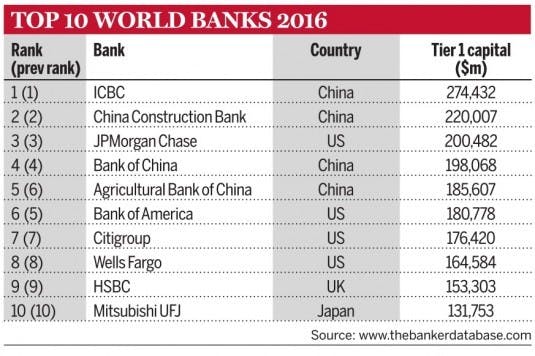
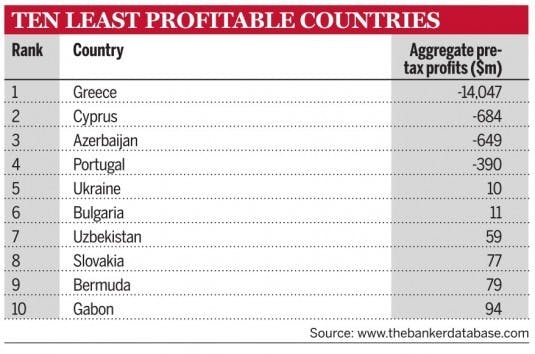
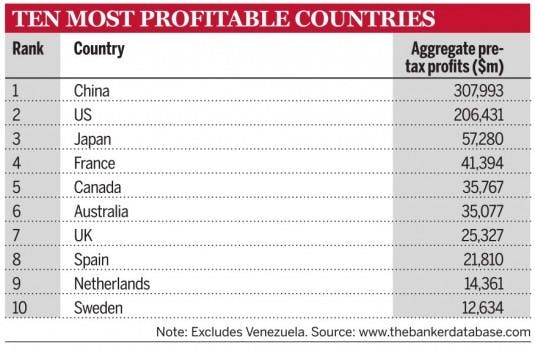
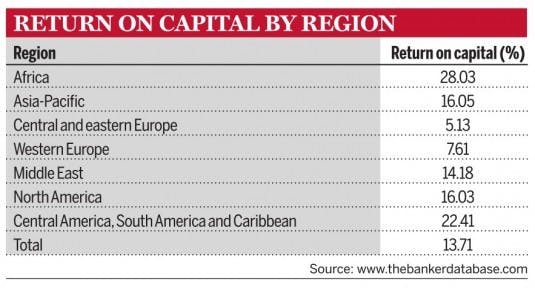
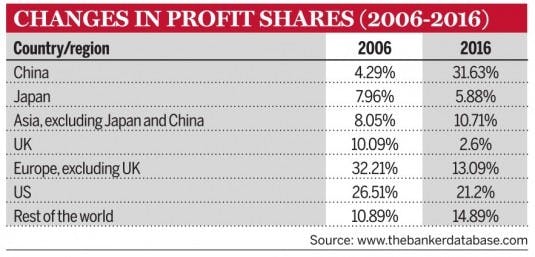
- ends -
FT:
Catherine Goacher
T: 0207 873 4181
E: catherine.goacher@ft.com
Launch PR:
Alice Carr
T: 020 7758 3911
E: alicec@launchpr.co.uk
Sophie Longley
T: 020 7758 3929
E: Sophiel@launchpr.co.uk
About The Banker:
The Banker is the world’s premier banking and finance resource, providing global financial intelligence since 1926.
The Banker is the key source of data and analysis for the industry. The Banker’s Top 1000 World Banks ranking has been setting the industry benchmark since 1970, providing comprehensive intelligence about the health and wealth of the banking sector. To find out more visit www.thebanker.com/top1000worldbanks.
Brian Caplen has been a financial and business journalist for more than 25 years. He has worked in Hong Kong and the Middle East and reported from all over the world. He joined The Banker in 2000 and became editor in 2003.
About The Banker Database:
The Banker Database provides comprehensive financial data, news feeds and executive contact data on the leading banks in every country. Our data has been standardised for regional reporting and regulatory variations, and forms the basis of The Banker’s monthly bank rankings.
Over the past five decades our rankings have become the industry standard for measuring bank performance and strength. The database tracks banks in more than 190 jurisdictions representing 90% of the world’s total banking assets. To find out more about The Banker Database visit www.thebankerdatabase.com.
About the Financial Times:
The Financial Times, one of the world’s leading business news organisations, is recognised internationally for its authority, integrity and accuracy. Providing essential news, comment, data and analysis for the global business community, the FT has a combined paid print and digital circulation of 793,000. Mobile is an increasingly important channel for the FT, driving half of total traffic.